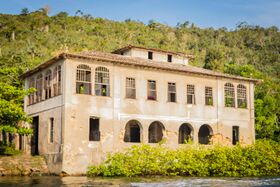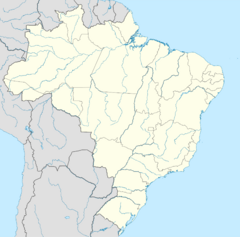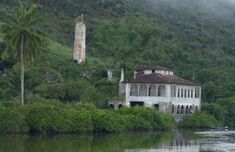Biology:Engenho Vitória
| Engenho Vitória | |
|---|---|
 Engenho Vitória in 2017. | |
| Alternative names | Vitória Sugar Mill |
| General information | |
| Type | Engenho |
| Town or city | Countryside of Cachoeira, Bahia |
| Country | Brazil |
| Coordinates | [ ⚑ ] 12°39′44″S 38°56′26″W / 12.66222°S 38.94056°W |
| Construction started | 1812 |
Engenho Vitória is a sugarcane mill founded in the nineteenth century, located on the banks of the Paraguaçu River in the countryside of Cachoeira, Bahia, Brazil.[1][2][3]
History
The year 1812 marks the beginning of the construction of Engenho Vitória, on the banks of the Paraguaçu River, an important watercourse in Bahia, near Cachoeira.[4][5] The work was sponsored by the Commander Pedro Bandeira, an important merchant of his time and one of the pioneers in the use of steam navigation in Bahia.[6][7]
Built in the period of Colonial Brazil, the Engenho building is connected to the slavery process in Brazil, as it was a place that used slave labor during its operation as a sugar business.[8][9][10] The mill consists of a three-level sobrado, based on an architectural project that imagined the construction of the building with a "T" shape.[6] The building includes covered access between the engenho and the sobrado.[4] There is also a marble hall, chapel, storage room and a room for the slaves.[9] The building also has an attic – later renovated and expanded.[6] The property also mentions Bandeira's family, with references to his family on the door and the Muniz family coat of arms carved in marble.[4]
Heritage register
In 1943, the mill underwent the process of historical listing with the National Institute of Historic and Artistic Heritage (IPHAN), the organization responsible for historical preservation linked to the Federal Government.[4][11][12]
See also
- Slavery in Brazil
- Trapiche
- Sugarcane mill
- Empire of Brazil
- Bahia
- List of National Historic Heritage sites of Brazil
References
- ↑ Azevedo, Esterzilda (2009). "Engenhos do recôncavo baiano". http://portal.iphan.gov.br/uploads/publicacao/ColRotPat7_EngenhosReconcavoBaiano_m.pdf.
- ↑ "Cachoeira". https://cidades.ibge.gov.br/brasil/ba/cachoeira/historico.
- ↑ (in pt) Vídeo Teaser – Mural de Aventuras e CT de Cachoeira no Engenho da Vitória, https://www.youtube.com/watch?v=IPNmsZAp-Jg, retrieved 2021-07-19
- ↑ 4.0 4.1 4.2 4.3 "Engenho Vitória: sobrado, capela, crucifixo, senzala e banheiro (Cachoeira, BA)". http://portal.iphan.gov.br/ans.net/tema_consulta.asp?Linha=tc_belas.gif&Cod=1045.
- ↑ GENZ, FERNANDO; LESSA, GUILHERME; CIRANO, MAURO (2008). "Vazão Mínima para Estuários: Um Estudo de Caso no Rio Paraguaçu/BA". Revista Brasileira de Recursos Hídricos 13 (3): 73–82. doi:10.21168/rbrh.v13n3.p73-82. ISSN 2318-0331.
- ↑ 6.0 6.1 6.2 "Cachoeira – Engenho Vitória" (in pt-BR). 9 August 2019. http://www.ipatrimonio.org/cachoeira-antigo-engenho-vitoria/.
- ↑ ""200 anos do Vapor de Cachoeira" em seminário dia 3 de outubro, no IGHB" (in pt). 24 September 2019. https://www.ighb.org.br/single-post/2019/09/24/200-anos-do-vapor-de-cachoeira-em-seminário-dia-3-de-outubro-no-ighb.
- ↑ Sugimoto, Luiz (25 March 2007). "Do cativeiro às ruas" (in pt). https://www.unicamp.br/unicamp_hoje/ju/marco2007/ju352pag12.html.
- ↑ 9.0 9.1 FILHO, Walter (2006) (in pt). Encruzilhadas da liberdade: histórias de escravos e libertos na Bahia, 1870–1910. Campinas: Editora da Unicamp. pp. 366.
- ↑ Reis, João. "Recôncavo Rebelde: revoltas escravas nos engenhos baianos." (in pt). https://repositorio.ufba.br/ri/bitstream/ri/3589/1/afroasia_n15_p100.pdf.
- ↑ "O Iphan" (in pt). http://portal.iphan.gov.br/pagina/detalhes/872.
- ↑ Mariuzzo, Patrícia. "Trens e cana-de-açúcar" (in pt). http://www.labjor.unicamp.br/patrimonio/materia.php?id=167.
Note: This topic belongs to "Brazil" portalTemplate:Brazil-hist-stub
 |



